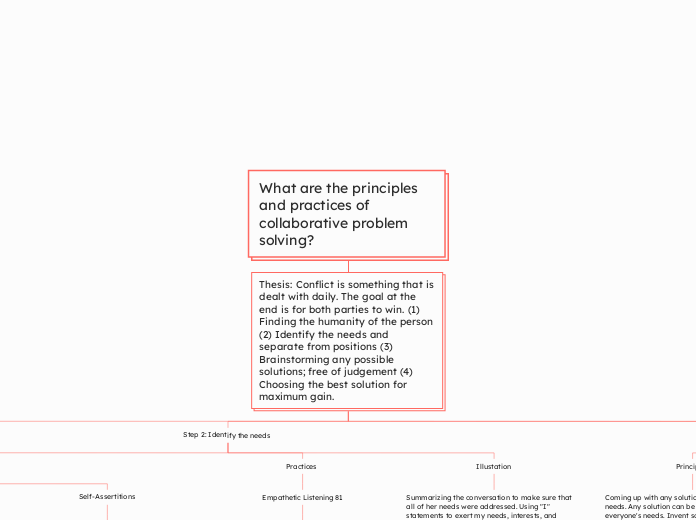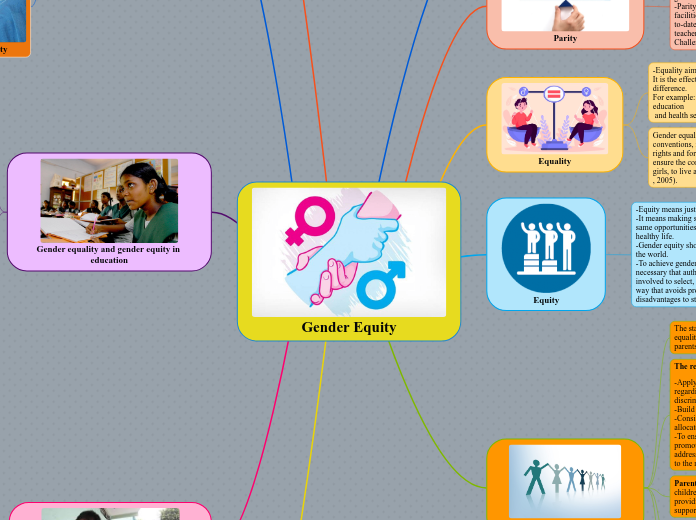What are the principles and practices of collaborative problem solving?
Thesis: Conflict is something that is dealt with daily. The goal at the end is for both parties to win. (1) Finding the humanity of the person (2) Identify the needs and separate from positions (3) Brainstorming any possible solutions; free of judgement (4) Choosing the best solution for maximum gain.
Step 4: Choosing the best solution
Filtering out the solutions to get maximum gain. Agree on the solution that meets ours needs. The solution we decided on was I would modify DND. Don’t put it on at all times. My Parents can contact me and be able to see their messages. how win/win?
Narrowing down what is the best solution to meet both needs. Evaluate each solutions to find the ideal solution. Creating some common ground with the parts of the solution.
Evaluating solutions
Narrowing down what is the best solution to meet both needs. Cutting out solutions that don't benefit both people.
Finding maximum gain solutions
The end result is a win-win solution. Meeting the needs of both individuals. Inventing novel solution to internal conflicts.
Creating Common Ground
The main solution that builds them together. Building on the existing material to create something new. Listing to the other person for ways to create novel ideas.
Step 3: Brainstorming
Coming up with solutions that can benefits both of our needs. Throwing out ideas that are outside of the box. Some of the ideas we came up with are Text my mom where I am,Bring portable charger around, and Not using DND at all times. One thing to make it better was thinking of more creative solutions. ADD something about how you could have generated MORE solutions...
Working together to identify and generate as many solutions. Make a list of any solutions. No solution is considered a bad one. Avoid judging and evaluate ideas. Getting creative with the solutions; thinking outside of the box. Creating some common ground with the parts of the solution.
Principle
Coming up with any solutions to benefit both needs. Any solution can be the right one to meet everyone's needs. Invent solutions that bring maximum gain.
One quote from the book" The most important aspect of this step is to avoid judging whether the solutions you generate are good or bad. Simply work together to generate as many ideas as possible for the full range of the problems before you." Practicing credulity to understand the other person. Some solutions make sense
Step 2: Identify the needs
Summarizing the conversation to make sure that all of her needs were addressed. Using "I" statements to exert my needs, interests, and feelings. I used "I" statement to express my needs in the conversation. My mom is being empathetic about my situation. Articulate what needs you both had.
Practices
Empathetic Listening 81
There are five steps to empathetic listening. (1) Asking questions about the needs of your partner. (2) Be quiet when they are talking. (3) After their done talking recap the conversation. (4) Letting your partner to correct you. (5) Being empathetic for your partner.
The way we understand the events and the significance. Give an unbiased perspective. Give a factual representation. Describing the event but not recognize emotions.
Principle 64
Self-Assertitions
Using I-statements to talk about your needs, interests and feelings and describe concrete events. Changing the way that we talk. Basing our statement on actual event rather than characterizing. After the person is done talking it your time to express your needs.
Separating needs from positions
Needs
Person's needs, interests, wants, and desires.
Many solutions that can benefit both needs.Desires of the persons and the ways to solve the problems
Positions
The side that the person is on the problem. Mostly a one-sided solution that only benefits one person. Bargaining the needs of others.
Step 1: Finding the humanity of the other.
Illustation
In my own experience with my own conflict, My mom and I had a conflict about tracking me on my phone. Letting my mom talk about their needs without interruptions. Practicing compassion towards my mom. Being sympathetic about my mom's needs. Her needs are for me to be safe and know where my location is. One thing that I should have been more curiosity. I think my body language could have been better. Being in the moment and mind not wondering around.
Practices
Be aware of body language
Paying attention to the person. Being in the room mentally; not zoning out.
Don't Judge
Stay in the conversation and avoid insulting each other. Constructive criticism is needed to meet each other's need.
Ask question of the person's feelings 67-70
Finding out why are they feeling a certain way. Being Compassionate toward their suffering to Ask them "Why do you feel____" to reveal the unmet needs and interests.
Principle
Credulity 46-47
The other person is a credible source. It might not make sense to use but for them it does. Conflicts can make affect them in different ways. It doesn't need to make sense for us but for them it does.
It relies on believing the other person. Working to find a solution to meet both needs. Opening to the possibility that you might be wrong.
Curiosity 45
Moral Humility: Opening up to being right and wrong in conflict. That the other person might have the right answers. Winding our minds to the possibility that we're wrong.
Intellectual Humanity: Asking them "why" questions to understand their way of thinking. It can provide answers to questions being asked. Socrates famously said "I know that I know nothing". We don't know every single detail. Problem solving is relying not only your but the other person.
Compassion 42
Having compassion toward the other person can make you understand them. The author said "The moment we begin to think of our adversaries in terms of their suffering, everything changes." (pg 42) They are in the same position that we're in. Being compassionate to them can rectify the same reaction.
Empathy 85
Practicing empathetic listening in conflict. Letting them to talk about their side of conflict. Don't interject while they're talking or criticizing you in the process. Summarize and recounting what they were saying.









